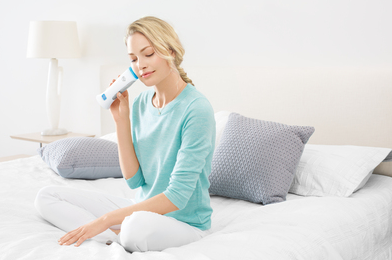How to Safely Use Acne Clearing Blue Light Technology
Acne has always been a formidable foe in the quest for beauty. Human beings have tried all manner of solutions for getting rid of blemishes, and some have been more effective than others. Blackstrap molasses, sulfur, cabbage leaves, watermelon juice, and even arsenic have all been used to rid people of pimples over the years. Thank goodness for modern science!
Blue light photodynamic treatment is one of the latest innovations in the fight against pimples, blackheads and whiteheads, and blue light practitioners and users say it's quite effective. Of course, being the first to jump onto the bandwagon of a new medical treatment isn't always the smartest move. So what about blue light treatment? Is it effective? And more importantly, is blue light treatment safe to use?
What Actually Causes Acne?
Acne isn't caused by lying or chastity, as was once believed. The truth is that our pores sit atop oil-producing glands. These glands are important because they keep our skin pliable and moisturized; however, they can sometimes become clogged with dead skin and debris.
When that happens, acne-causing bacteria become trapped inside the pore. But pores have a backup plan: they trick the body's natural defenses into attacking the skin, thereby creating a pimple. When the pimple drains, the bacteria are able to escape and colonize yet another pore, and the cycle continues.
How Blue Light Treatment Works
Like all bacteria, P. Acnes have cell membranes. As it turns out, the resonant frequencies in pigments inside those cell membranes correspond very neatly to the frequency of blue light. When exposed to blue light, the cell membranes are broken, and the bacteria die.
Have you seen a video of an opera singer shattering a wine glass? It's basically the same concept: The light is like the singer, and the cell membranes, the glass.
Is Blue Light Treatment Effective?
In laboratory conditions, blue light kills 99.99% of exposed acne bacteria. In the real world, bacteria hidden deep within pores may escape blue light treatment, but bacteria within reach of the blue light respond similarly to bacteria exposed to blue light in scientific tests.
In short, blue light treatment has been shown to be very effective at treating acne, especially when used in concert with a healthy skincare regimen.
It's important to remember that blue light photodynamic therapy typically requires several treatments. Those looking for a magic bullet should bear in mind that experts recommend a series of treatments over the course of several weeks, followed by monthly maintenance treatments. Suffice it to say, these treatments can add up, unless you invest in a home blue light system.
Many users of blue light therapy report visible results within 2-4 treatments, or about two weeks' time.
How Safe Is Blue Light Acne Treatment?
Blue light treatment is generally recognized as a safe, effective and non-invasive acne treatment. It's been FDA-cleared to treat moderate acne and is a great alternative to prescription oral or topical treatments which can be harsh or irritating to the skin.
Side effects of blue light photodynamic acne treatments are typically mild, and may include temporary swelling, dryness and pigment changes, but many users experience no side effects at all.
As with any treatment, it's important to use blue light photodynamic acne therapy with care. If using a personal blue light treatment solution, follow the instructions to achieve optimal results. Be diligent with your treatments so you can get the best results.
Get Dermatologist-Quality Skin at Home
If you're interested in trying blue light treatment for yourself and would prefer do it in the comfort of your own home, then check out Tria Beauty's
Acne Clearing Blue Light. More than 90 percent of users agree that it's gentle and effective, and nearly as many say it's better than their former skin care regimens.


